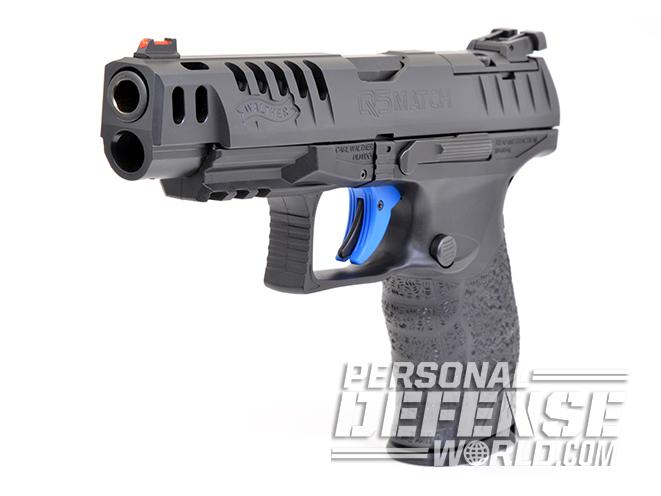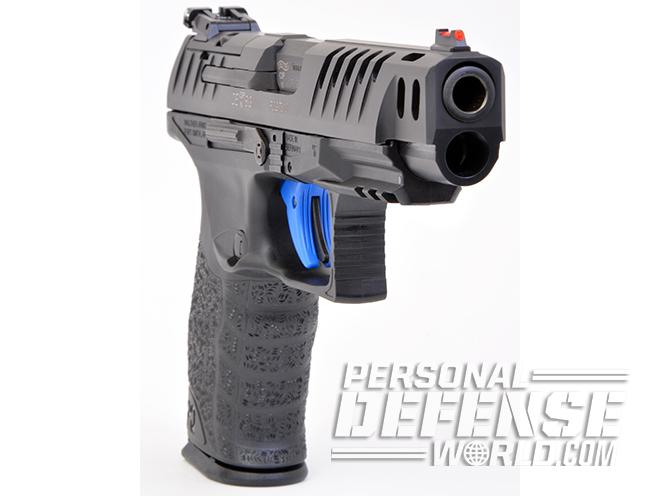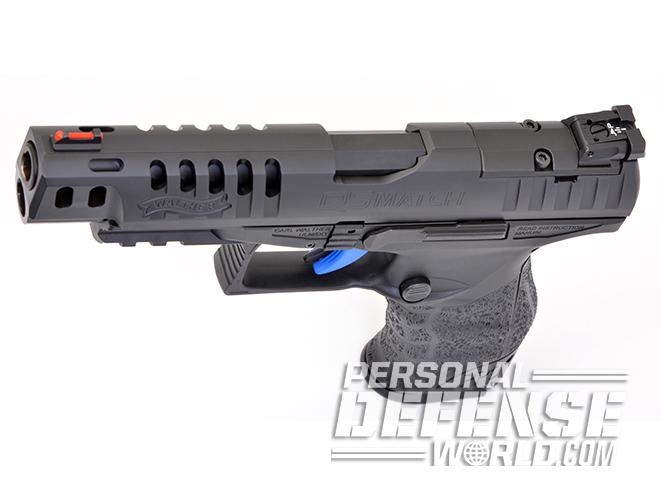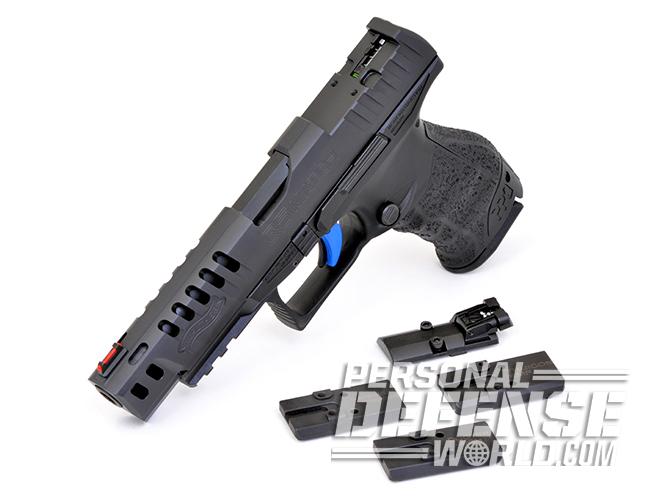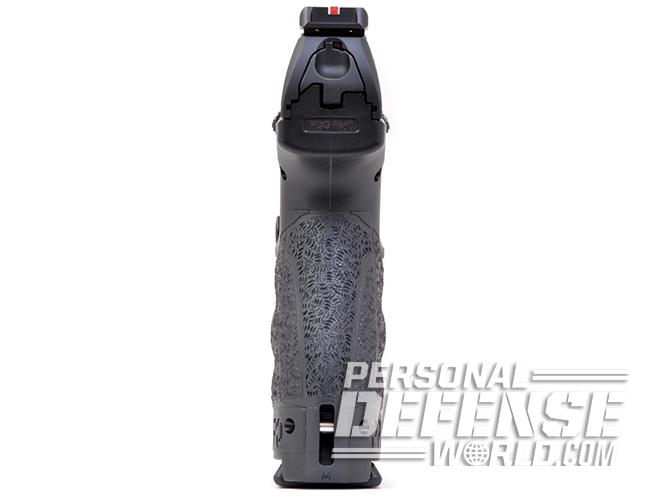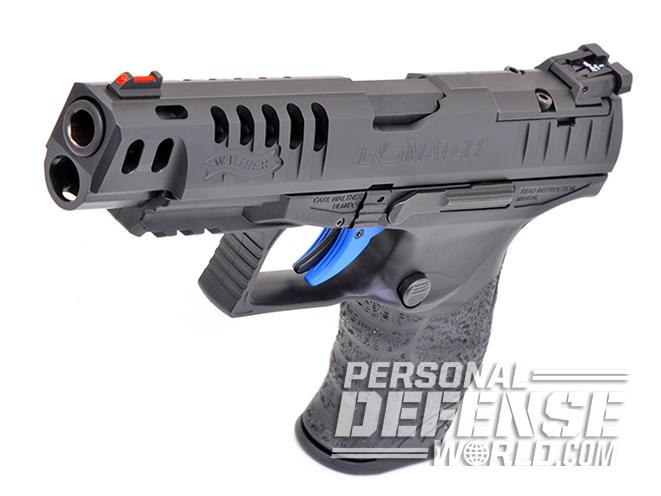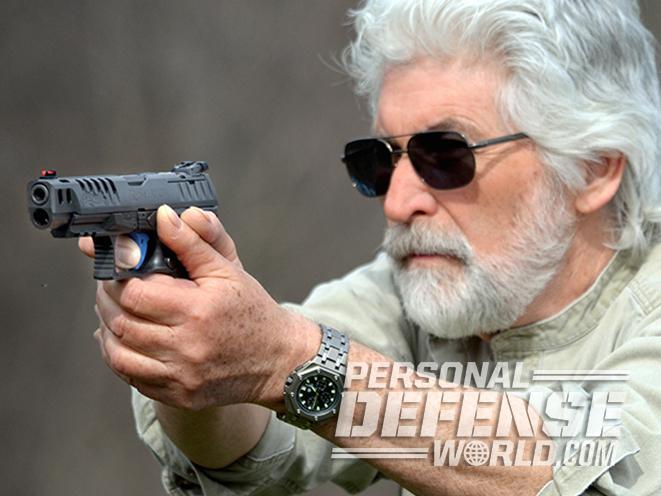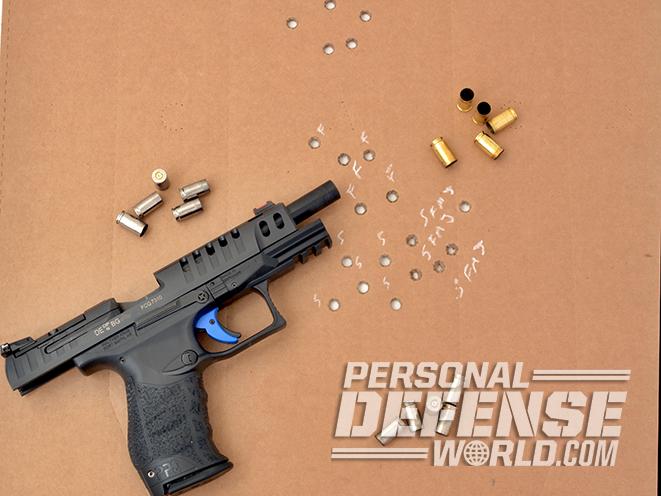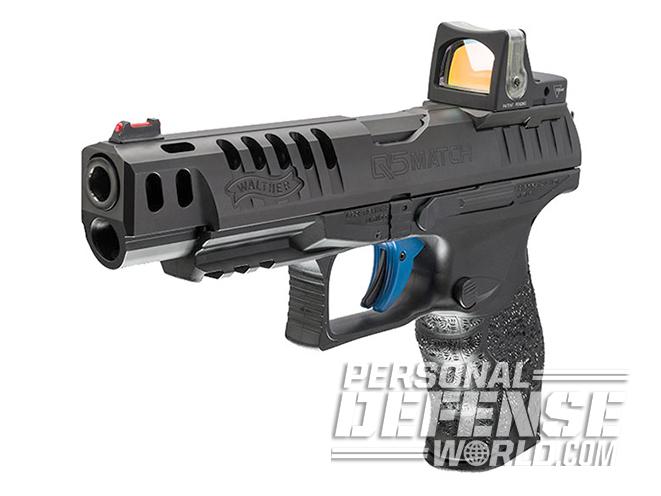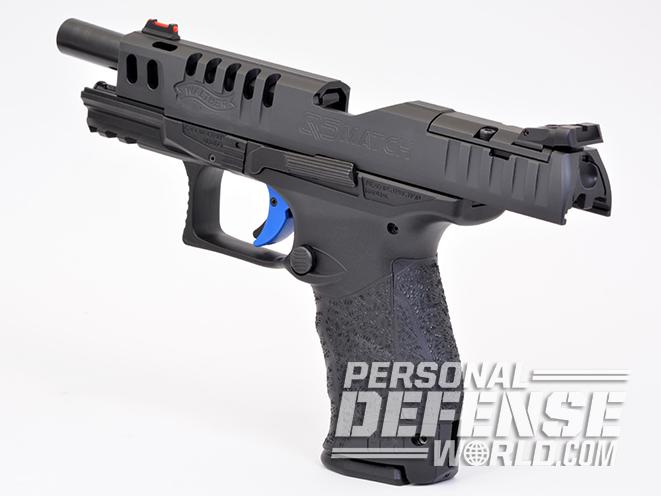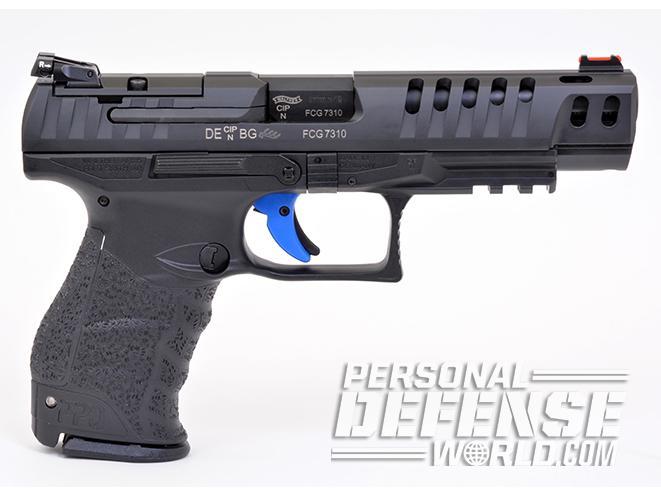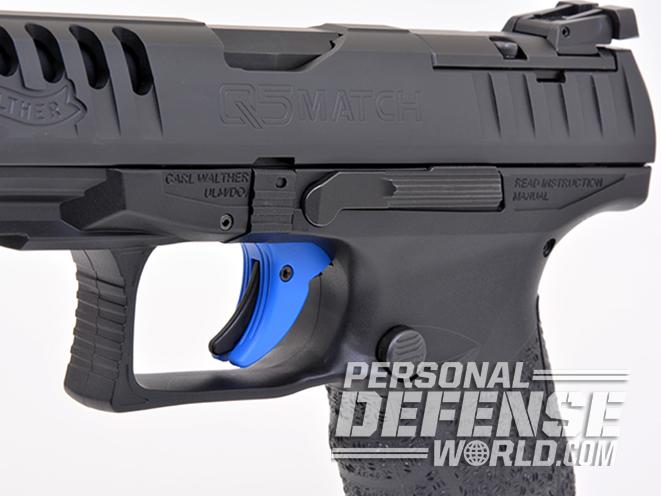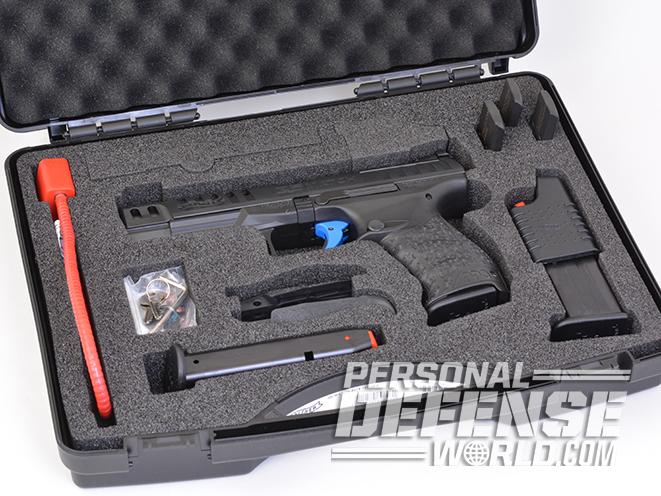It is no secret to anyone who has been reading my articles and gun tests over the years that I have a favorite semi-auto handgun—the Walther P99. In many articles, especially those involving striker-fired semi-automatics with polymer frames, it is the gun (if not in words, then in my mind) by which all others are compared. Granted, there are several of late that have exceeded it, but most, in one way or another, only emulate it. Thus, for Walther to surpass its own design is an achievement. The Q5 Match is such a gun.
Q5 Match History

The Q5 Match is a production-class competition version of the 5-inch-barreled PPQ M2 introduced in 2013. The original PPQ design—let’s call it the PPQ M1—was an “evolution” of the circa-1997 Walther P99, the arms-maker’s first polymer-framed, striker-fired semi-auto, and when the first PPQ was introduced in 2011, it was essentially a direct upgrade based on the P99 platform. The new design eliminated some of the features that made the P99 desirable; one of the most noteworthy was the DA/SA trigger and decocker, which was replaced on the PPQ with an SAO trigger incorporating an integral blade safety. Walther named its variation of the Glock design the “Quick Defense” trigger system, which was actually developed for the P99 QA (Quick Action) model. The trigger safety eliminated the “technical” need for the P99’s decocking system, which in the minds of many remains one of the P99’s best features. The trigger on the PPQ series also eliminated the second-strike capability as well as the P99’s striker status indicator, which protruded from the back of the slide when the action was cycled. On the plus side, you gained the lighter “Quick Defense” trigger, improved front and rear slide serrations and enhanced grip texturing on the polymer frame.
The PPQ M2 (introduced in 2013) did away with the last of the P99’s unique design characteristics—the ambidextrous magazine releases incorporated into the back of the triggerguard—replacing them with a conventional frame-mounted button on the left side that is also reversible for left-handed operators. The 5-inch-barreled PPQ M2 version—the predecessor of the Q5 Match—also introduced a ported, 8-inch-long slide with six heat-dissipating vents. The Q5 Match has upped that number to 16 vents, which gives it an impressive race-gun appearance and further lightens the slide’s weight to slightly increase the pistol’s cycling time.
Advertisement — Continue Reading Below
- RELATED STORY: Walther’s PPQ M2 Pistol – Now Available in .45 ACP
The adjustable, low-profile, white-dot sights from the 5-inch-barreled PPQ M2 have been improved on the Q5 Match with a red fiber-optic front sight and a fully adjustable LPA target rear sight, plus an interchangeable optics mounting platform is machined out of the top of the slide at the rear. Competition gun builders call the recessed mounting plate design a “melt,” which is intended to keep the mounting plate flush with the top of the slide and thus lower the optics to be more in line with the bore (rather than higher, as with mounts that are on top of the slide). It is a more efficient and compact design identical to the Glock MOS configuration and other competition pistols utilizing quick-change mounting plates. The Walther design also removes the LPA target rear sight, which is dovetail-mounted to the standard Q5 Match baseplate. The LPA rear sight can also be independently removed from the plate and switched for other target, white-dot or tritium sights. The front sight is replaceable as well, so the gun can be completely tailored to fit a shooter’s personal preferences.
The Q5 retains the same grip angle and interchangeable backstraps, width and height of the standard 5-inch-barreled PPQ M2, and it has an overall length of 8.1 inches, a height of 5.3 inches, a width of 1.3 inches and an unloaded weight of 27.9 ounces. This is a very comfortable handgun to grasp; it’s hand filling but well balanced. The Q5 Match also features an ambidextrous slide release with elongated levers (1.94 inches long) that develop the requisite torque to effortlessly release the slide after reloading.
Competitive Edge

The 5-inch-barreled PPQ M2 introduced in 2013 was intended for competition shooting, and while it’s an excellent target pistol, it did not go far enough beyond offering a longer barrel, six slide vents and adjustable white-dot sights. The Q5 Match takes the final step with 16 slide vents, improved sights and its special trigger.
Advertisement — Continue Reading Below
The bright blue Quick Defense trigger not only sets this model apart from the rest of the PPQ M2 line, but it also levels the playing field with many of its competitors. The match trigger only requires 0.5 inches of take-up (including the blade safety) and has a short 0.125-inch reset. The trigger pull on my test gun averaged 4.89 pounds. This compares to the 5-inch-barreled PPQ M2’s average trigger pull of 5.15 pounds (from my Combat Handguns test back in 2013). As a point of reference, the single-action trigger pull on my Walther P99 averages 6.25 pounds. So, as you can see, this blue trigger is light, fast and exactly what you’d want in a competition pistol.
The Q5 Match also comes with a medium- sized backstrap panel in place, plus a smaller panel to decrease the grip’s depth and a larger panel that increases the curvature of the grip frame for the web of the hand. For me, the medium panel is a good fit, placing the strong-hand thumb over the top of the middle finger when using a one-handed hold. This is an optimum grip position. Using a traditional two-handed hold, this also places the strong-hand thumb over the support-hand thumb.
This new Walther is really a system that comes in a high-impact polymer case with a foam-lined interior to hold the Q5 (with one 15-round magazine inserted), the extra backstrap panels, two additional magazines, a Walther magazine loader, three optics mounting plates for Docter, Leupold and Trijicon reflex sights, and a cable safety lock. The foam cutout also has a removable section to accommodate the Q5 Match with optics mounted. Also, it’s worth noting that the Q5 Match magazines are specially marked, “PPQ M Series Cal. 9mm.”
Advertisement — Continue Reading Below
On The Firing Line

The Q5 Match comes packed with a factory test target shot from a benchrest at 25 meters (82 feet). The test target had five shots at 1.068 inches with one pair overlapping. For my range test, I selected three different types of 9mm ammunition: Sig Sauer Elite Performance 115-grain FMJs, Federal Premium 124-grain Hydra-Shok JHPs and Sig Sauer 124-grain Elite Performance V-Crown JHPs. The Sig FMJ rounds are rated for a muzzle velocity of 1,185 fps, and they chronographed from the Q5 Match barrel at 1,295 fps on average. The Sig V-Crown JHPs are rated at 1,189 fps and averaged 1,191 fps while the Federal Hydra-Shok JHPs are rated at 1,120 fps and cleared the ProChrono traps at 1,172 fps. The recoil with all three loads was equally manageable with the Q5 Match, although I have to say that the ported, lighter-weight slide does come back pretty snappy.
- RELATED STORY: Gun Review – The Affordable Walther Creed Pistol
For the final test, I set up a Law Enforcement Targets IPSC cardboard competition silhouette 25 yards downrange and fired five rounds per target with each type of ammunition, shooting from a rested position. I wish I could say I did as well as the gentlemen at the Walther factory, but not quite. My best five-round groups averaged 2 inches together, with the best groups measuring 1.74, 2 and 2.5 inches with the Sig JHP, Sig FMJ and Federal loads, respectively. I also fired five of the Sig V-Crown JHPs off hand from 15 meters—one of the competition distances in IPSC—and placed all five rounds in the A-zone of the IPSC target with a 1.75-inch cluster.
This pistol is extremely easy to shoot, operate and field-strip. It is accurate, fast and reliable as the day is long. In short, it is everything you expect from Walther.
Advertisement — Continue Reading Below
For more information, visit waltherarms.com.
This article was originally published in “Combat Handguns” September/October 2017. To subscribe, visit outdoorgroupstore.com.
